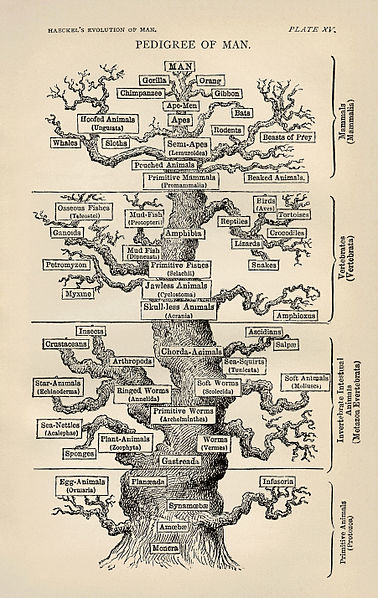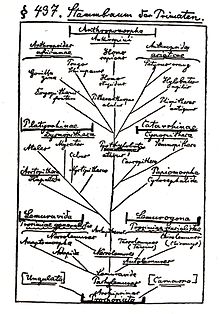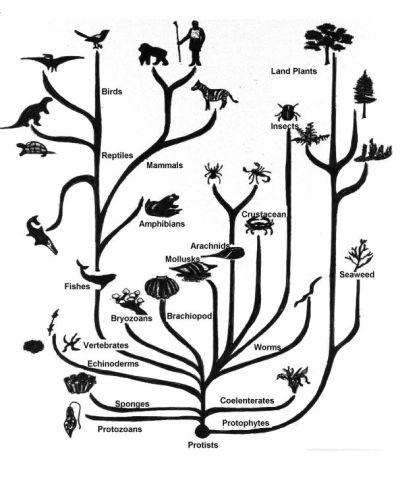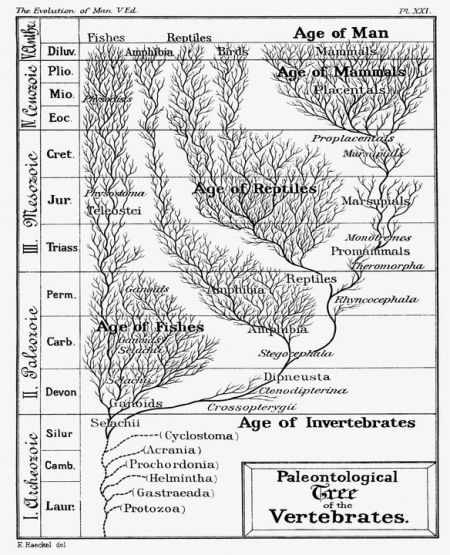The Phylogenetic Tree: Haeckel's trees

Ernst Haeckel's tree of life. Here Darwin's description of the pattern of universal common descent is presented in beautiful artistic form. With Darwin in England and Lamarck in France, Haeckel in Germany was one of three the great popularisers of evolution. The above is from the English version of The Evolution of Man. For Haeckel, as for many early evolutionists, humans were considered the pinnacle of evolution. In fairness to Haeckel he also produced less anthropocentric tree diagrams (see below right). - from Wikipedia |

Haeckel's Stambaum der Primaten (1860s). via Wikipedia |
Whilst Charles Darwin was the author of the empirical theory of evolution, it was his German counterpart and follower Ernst Haeckel who established the subfield of phylogeny (one of the many words he coined) as the study and science of the evolutionary relationships of life. Unlike Darwin's abstract trees, Haeckel, who was a brilliant illustrator, enthusiastically constructed several Trees of Life that were intended to convey the actual phylogenetic history of life, in terms of branching taxa. These diagrams, when representing life as a whole, became known (following the biblical phrase) as the "Tree of Life". Several such diagrams are shown on this page.

Haeckel's Tree of Life in Generelle Morphologie der Organismen (1866). This, the first truly modern Tree of Life, shows the three kingdoms of Plantae, Protista and Animalia, via Wikipedia |
At the left is the first sketch of the famous Haeckel's Tree of Life in the 1870s which shows "Pithecanthropus alalus" as the ancestor of Homo sapiens. Later when Haeckel's student duBois discovered Homo erectus in Java he named it Pithecanthropus erectus.
At the top of this page is his famous illustration the "Pedigree of Man" published in The Evolution of Man (1879), which shows Haeckel's Ladder of Nature/Great Chain of Being perspective with Homo sapiens at the top, an image as iconic as the much misunderstood March of Progress, and which perhaps was the ultimate inspiration for the latter (although both go back ultimately to great chain of being / ladder of nature thinking). Although this would seem an anthropocentric step backwards in relation to his earlier (1866) but more contemporary-looking three-kingdom model, shown at the right, it should be remembered that for Haeckel, as for many 19th century evolutionists, humans were considered he pinnacle of evolution. Teilhard de Chardin serves as a 20th century example.

Version of the Tree of Life, from "A Simplified Family Tree of Life" in The Evidence of Evolution by Nicholas Hotton III, Smithsonian, c1968 via Think Quest |
Haeckel's influence was considerable; modern versions of his trees can be seen in any biological textbook or popular science book. Inevitably, these diagrams retain ladder of nature thinking in that they have humans, butterflies, and flowering pants at the summit, with lesser forms of plants, invertebrates, and vertebrates beneath them. A typical diagram is shown here (left)
As with this later diagram, Haeckel's original trees showed the branching order only, and often featured purely speculative organisms based on embryology or on Haeckel's theorising regarding the origin of man.

Tree of Vertebrates, from Ernst Haeckel's The Evolution of Man, fifth edition, London, 1910 |
An interesting diagram widely available online (e.g. Heritage Images, Science Rules!, Wikipedia) shows the transition from mid to late 19th century phylogenetic ladder of nature, shown in the above three diagrams, to a type of representation common in 20th century paleontology textbooks which plots phylogeny and diversity against geological time. This paleontological tree of vertebrates (right) is shows the beginning of the spindle diagram. According to the captrion on the Heritage Images page (the only one that gives information about it) it is from the fifth edition of Haeckel's The Evolution of Man, published in 1910. This would put it late in Haeckel's career, reflecting the growing understanding of the diversity of life through time, although this march of life - minus the phylogeny - originates with early 19th century non-evolutionist paleontologists like Cuvier and Owen. Here we see Earth history in terms of successive ages of Invertebrates, Fish, Reptiles, Mammals, and Man, a terminology that was standard in science books until the cladistic revolution. The individual twigs are no longer labelled, but symbolic only, with diversity represented by the width of each class through time. However even this is quite inaccurate, as for example in real life there are twice as many extant species of birds than mammals, while fish (chiefly teleosts) equal all tetrapods combined. And reptiles themselves were highly diverse during the Permian. Ironically, the geological and paleontological convention of placing the oldest ages at the bottom and the newest at the top fits with Haeckelian (and pop-Darwinian), great chain of being thinking, according to which the "lower" forms of life appear first and hence, mapped against the geological column, would also branch off lower in the geological sequence
By the early 20th century, paleontology and our understanding of the history of life had taken on a mostly modern form. It was left to the evolutionary systematicists of the mid 20th century to eleimante the remnant Great Chain of Being representation integrate Haeckelian style phylogeny with Linnaean taxonomy, Darwin-Mendel evolutionary synthesis, the fossil record and the geological timescale in an empirical synthesis. Evolutionary systematic paleontologists would supplement Haeckelian trees with more sophisticated spindle diagrams that mapped geological time (vertical axis) against taxonomic diversity (horizontal width).
Replacing evolutionary systematics in the 1980s, cladistics used their own tree diagrams, called cladograms, that nevertheless were strikingly similar to Haeckel's in that they emphasise branching sequence (cladogenesis) rather than time or diversity as a way of presenting phylogentic hypotheses. Cladistics however differs from Haeckelian phylogeny in being far more rigorous in approach, and mapping the branching order (the tree shape or topology) with much greater precision. Based on both gross morphology and molecular sequencing, cladograms became the visual representation of the modern statistical-quantitative science of phylogenetics. These cladograms are strandard in textbooks today. MAK130419.




